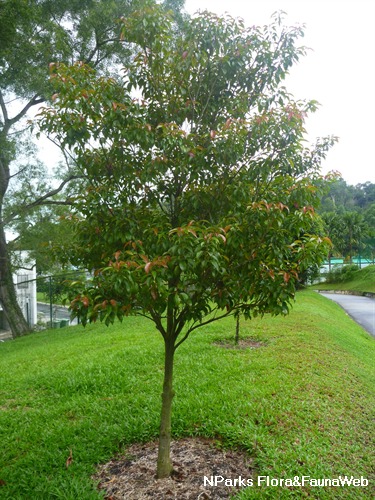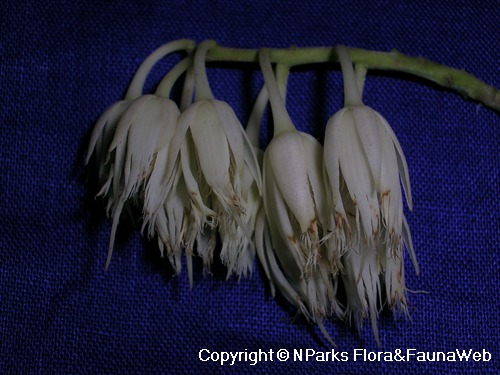
Back
Elaeocarpus pedunculatus Wall. ex Mast.
| Family Name: | Elaeocarpaceae |
| Common Name: | Blunt-leaved Oil-fruit, Pinang Punai, Derumun Padi |
Name
Classifications and Characteristics
| Plant Division | Angiosperms (Flowering Seed Plants) |
|---|---|
| Plant Growth Form | Tree (Medium (16m-30m)) |
| Lifespan (in Singapore) | Perennial |
| Mode of Nutrition | Autotrophic |
| Plant Shape | Tiered |
| Maximum Height | 27 m |
Biogeography
| Native Distribution | Sumatra, Peninsular Malaysia, Singapore, the Philippines, and Borneo |
|---|---|
| Native Habitat | Terrestrial (Primary Rainforest, Inland Cliff, Mountain, Secondary Rainforest, Coastal Forest) |
| Preferred Climate Zone | Tropical |
| Local Conservation Status | Native to Singapore (Least Concern (LC)) |
Description and Ethnobotany
| Growth Form | Itis a tree up to 27 m tall, with branching similar to that of the sea-almond tree (Terminalia catappa). |
|---|---|
| Foliage | Itsspirally arranged, stalked leaves have thinly leathery to leathery leaf blades that are drop-shaped to narrowly drop-shaped, blunt or slightly tipped, and 6.4–13 by 2.5–6.4 cm. |
| Flowers | Its white flowers are 7.6 mm wide and grow in 3.5–11 cm long flowering shoots that develop in the axils of the leaf scars. |
| Fruit | Its oblong fruits are drupes, greyish-blue with green oily pulp, and 13 by 8 mm. |
| Habitat | It grows in lowland to montane forests, including secondary forests, limestone hills, and rocky cliffs by the sea, up to 1,220 m altitude. |
| Associated Fauna | Its flowers are insect-pollinated. The fruits are eaten by birds. |
| Cultivation | It can be propagated by seed. |
| Etymology | Greek elaia, olive; Greek karpos, fruit, referring to its round fruits; Latin pedunculatus, with a well-developed inflorescence stalk or peduncle |
Landscaping Features
| Landscaping | It is suitable for planting at roadsides, parks and gardens, or coastal areas. |
|---|---|
| Desirable Plant Features | Ornamental Form |
| Landscape Uses | General, Suitable for Roadsides, Parks & Gardens, Small Gardens, Coastal |
Fauna, Pollination and Dispersal
| Fauna Pollination Dispersal Associated Fauna | Bird-Attracting |
|---|---|
| Pollination Method(s) | Biotic (Fauna) |
| Seed or Spore Dispersal | Biotic (Fauna) |
Plant Care and Propagation
| Light Preference | Full Sun |
|---|---|
| Water Preference | Moderate Water |
| Plant Growth Rate | Moderate |
| Rootzone Tolerance | Moist Soils, Well-Drained Soils, Saline Soils / Salt Spray |
| Propagation Method | Seed |
Foliar
| Foliage Retention | Evergreen |
|---|---|
| Mature Foliage Colour(s) | Green |
| Mature Foliage Texture(s) | Leathery, Thin |
| Foliar Type | Simple / Unifoliate |
| Foliar Arrangement Along Stem | Alternate, Spiral |
| Foliar Attachment to Stem | Petiolate |
| Foliar Shape(s) | Non-Palm Foliage (Obovate) |
| Foliar Venation | Pinnate / Net |
| Foliar Margin | Serrate / Toothed |
Floral (Angiosperm)
| Flower & Plant Sexuality | Bisexual Flowers |
| Flower Colour(s) | White |
|---|---|
| Flower Grouping | Cluster / Inflorescence |
| Flower Location | Axillary |
| Flower Symmetry | Radial |
Fruit, Seed and Spore
| Mature Fruit Colour(s) | Green - Bluish Green |
|---|---|
| Fruit Classification | Simple Fruit |
| Fruit Type | Fleshy Fruit , Non-Accessory Fruit |
Image Repository
Others
| Master ID | 2003 |
|---|---|
| Species ID | 3295 |
| Flora Disclaimer | The information in this website has been compiled from reliable sources, such as reference works on medicinal plants. It is not a substitute for medical advice or treatment and NParks does not purport to provide any medical advice. Readers should always consult his/her physician before using or consuming a plant for medicinal purposes. |








